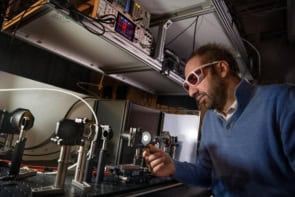Creating a quantum computer that integrates a large number of components is a huge challenge for many reasons. One is that most quantum bits (qubits) used today must be chilled to near absolute zero and therefore isolated from the room-temperature electronic components used to control them. This makes it extremely difficult to have large numbers of qubits and controllers packed into a small space. But researchers in the Netherlands may have a solution, as the science writer and educator Karmela Padovic-Callaghan explains in this episode of the Physics World Weekly podcast.
The “wonder material” graphene is a sheet of carbon just one atom thick that has extraordinary physical properties. One promising use for graphene is to make products more sustainable. On hand to talk about how graphene can do its bit to improve the environment is Andrew Pollard, who specializes in the metrology of 2D materials at the UK’s National Physical Laboratory.
Water is another substance that has wonderous properties that have proven very useful for sustaining life on Earth. Recently, researchers used a laser technique to study supercooled water in a previously inaccessible temperature regime. Katherine Skipper, a PhD student contributor to Physics World joins us to chat about this breakthrough. Skipper also talks about her research at the University of Bristol, which is focussed on active matter that comprises two-faced Janus particles.
- More information about the characterization and standardization of graphene can be found at these pages on the National Physical Laboratory website: “Structural and chemical characterisation of graphene”; “Graphene and 2D materials”; and “The importance of international standards for the graphene community”.



